The community development approach and the revitalization of DC's H Street corridor: congruent or oppositional approaches?
There is an op-ed ("The seeds of the H Street ‘miracle’") by the director of the DC branch of the Local Initiatives Support Corporation in tomorrow's Post, about how today's success of the H Street neighborhood, written about in newspapers like London's Financial Times and the New York Times, and called by Forbes Magazine one of the hippest neighborhoods in the U.S., is because of the long time involvement of the H Street Community Development Corporation in post-riot (1968) efforts to fix the declining neighborhood.
I have written about this a lot (e.g., "Missing the real point: city (re)development isn't about "gentrification" as much as it is about urbanism and urban design," "It's true that the winners in history revise it: misleading people about the process of change, H Street revitalization edition," and "H Street yet again"), and sometimes I joke that my involvement in urban planning to begin with is a form of "blowback" vis-a-vis the H St. CDC--where I tried to figure out why H Street NE languished, and what should have been differently--so I have a different opinion, I think.
I sent this to a neighborhood e-list, but have augmented it a little with some links and additions:
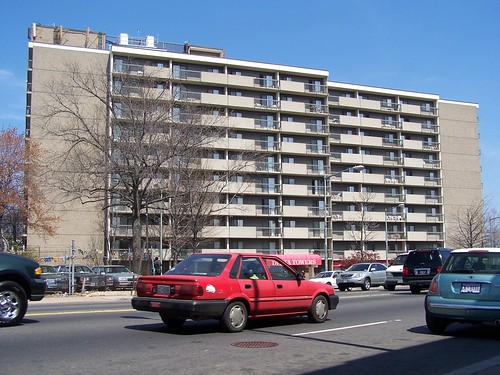 Delta Towers Senior Citizen Apartments.
Delta Towers Senior Citizen Apartments.... what I think is very interesting about this, and I could well be wrong, but have considered the question for 12+ years, is that for all the $100 to $150 million or more spent on H St. as a result of the H St. Urban Renewal Plan, H Street didn't improve. Here's what was done:
1. Hechinger Mall;
2. Bridge over railyard;
3. 2 senior citizen housing buildings;
4. a grab bag of new rowhouses constructed where frame buildings had been;
5. H St. Connection shopping center;
6. garden apartments in the place of the trolley barn on Benning Road;
7. Wylie Court condominiums;
8. the 2 office buildings on the 600 block;
9. the many years of lease payments for office space by DC government agencies in the 2 office buildings; and
10. Autozone.
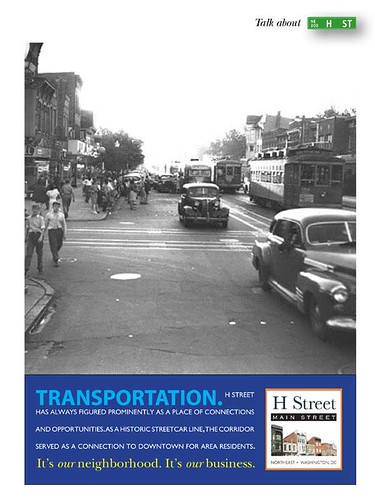 You can argue that all of these various projects, not all done by the CDC, stabilized the corridor for the next phase of improvement.
You can argue that all of these various projects, not all done by the CDC, stabilized the corridor for the next phase of improvement.Or you can argue that all of those investments didn't contribute fundamentally to the improvements of the H Street of today.
Right: one example of an ad in an H Street image advertising campaign that was developed by Kevin Palmer and myself, which ran in the Voice of the Hill community newspaper with the support of publishers Bruce and Adele Robey.
I tend toward the latter view for a couple reasons.
1. The economy of the subdistrict was broken and building new housing for poor people didn't change the economics of the area.
2. the urban renewal approach for the most part disregarded the kinds of characteristics (such as historic building stock) that tended to support sustainable urban revitalization initiatives in other cities.
3. The Atlas was owned but not really stabilized by the HSCDC and if someone didn't come around with an idea and plan for rehabilitating it, likely the ideas to have it become shopping and tear down part of it for parking--which was outlined on the HSCDC website into 2003-2004--likely would have occurred.
So the neighborhood and merchant response around 2000 against a proposal for a 50,000 s.f. BP gas station at the foot of the corridor led to a different approach to the corridor, one that was marginally more oriented to historic resources like buildings, but more towards smaller scale initiatives and businesses. This led to the creation of the H St. Main St. program in 2002.
And later this year (which shows how long change takes) the site that was going to be a gas station and convenience store will have 200+ apartments and a Giant supermarket, and will anchor further improvement efforts at the east end of the corridor.
Creating a 21st Century Revitalization Plan
At the same time, which is pretty much forgotten, then Councilmember Ambrose got the Office of Planning to do a revitalization plan for the corridor. While I would argue there are some serious flaws in the recommendations still, for the most part the study led to the repositioning of the corridor in the context of real estate development and location decisions.
The Streetscape Study and the coming of the Streetcar
That was followed by the H St. Streetscape and Transportation Study, which led to the streetscape improvements and supported the insertion of the streetcar into the corridor (which in large part is the result of a coordinated campaign orchestrated by past ANC Chair Joe Fengler.)

Plus, the Williams Administration fast tracked the rebuilding of the H St. Streetscape, by immediately putting it into the design and engineering phase. It took about 11 years, but for a transportation infrastructure project, that's a pretty fast period for realization. (Thinking about the length of time such projects take started teaching me about patience.)
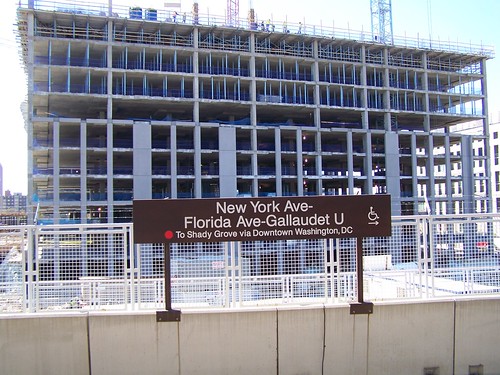 The NoMA infill subway station
The NoMA infill subway stationFurthermore, and irrespective of the improvements west of the railyard, I argue that the opening of the now named NoMA subway station in 2004 was essential to the revaluation and repositioning of the neighborhood north of H Street. (Not that any of you care, but observing the impact of the station led me to becoming a transportation planner instead of working on commercial district revitalization.)
Without Joe Englert, who knows where H Street would be today?
And all of that might not have made a difference had night life impresario Joe Englert (see "Joe Englert: The Life of the Party" from Washingtonian Magazine and "Joe Englert: Toast of the Town" from the Washington Business Journal) not decided to "make a stand" on H Street and develop a critical mass of night life establishments, by buying a bunch of buildings, leveraging the opening of the Atlas Performing Arts Center, and linking buildings + concepts + vendor relationships + financing + skilled operators into realizable, functioning businesses (aided by the ability to leverage expertise dealing with construction, the regulatory authority DCRA, ABRA--which regulates the sales of alcohol, and the Office of Tax and Revenue across multiple enterprises). Without functioning, exciting attractions, people wouldn't have started coming to the corridor.
 ... as important as infrastructure is, without places for people to visit (and spend money), you can't improve a commercial district.
... as important as infrastructure is, without places for people to visit (and spend money), you can't improve a commercial district.Above: the H Street Festival is now one of the city's most popular festivals, perhaps supplanting Adams-Morgan Day in the number of patrons.
But the creation of the H Street Main Street community organization was key to the new H Street
I think about the initiative to create H St. Main Street a lot. My line about it is that there wasn't consensus necessarily about the end outcome, but there was consensus that something needed to be done. And none of us--at least I couldn't--imagined that what we were working for is the H Street of today let alone the coming H St. in the new streetcar age.
In any case, it brought residents into the revitalization mix, when before most of the decisions and activities were by quasi-government and government agencies with limited input.
The H Street CDC actively opposed most of the post-2000 revitalization activities on the corridor
I just don't know how important the H St. CDC was to any of this.
They certainly were not a supporter (until very recently*) of any of what we would call the modern revitalization of H Street. Although they did sell the Atlas Theater building without making any profit on it, to the nonprofit organization that rehabilitated and reopened it, and I know that the former leadership of the organization considered that to be a tremendous contribution to the improvements while still being upset (a polite word) that they weren't able to profit at all from the sale (the city government strong-armed them into making the sale).
The CDC was obstreperous and opposed to the H St. Revitalization Plan. The CDC specifically organized opposition to a historic preservation study grant proposal which I wrote and the Historic Preservation Office funded in 2001-2002 and for which I served as project manager. (This study helped to stoke the improvement agenda for the corridor.)
Now that I think about it, they were against the creation of the H Street Main Street. They used to get a monthly feature article in the Hill Rag community newspaper, and I remember one particular piece where they criticized the H Street Main Street program as a creature of the National Trust for Historic Preservation. I'd have to dig through archives to find the pieces--but it's one reason why I used to support the Voice of the Hill and not the Hill Rag.
The CDC termed opposition by residents to particular businesses that were seen as flawed as race-based. I wrote about that a long time ago in a series that started with this entry, Commerz in the 'hood... (aka "Commerce as the engine of urbanism".
They kicked people out of some of the Board meetings, and didn't see a need to have public meetings.
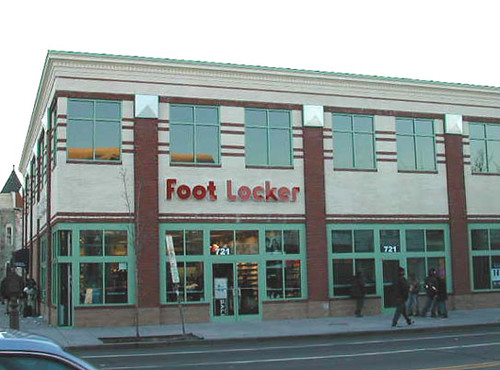 The then director and others had profit or equity positions in some of the projects and I seem to recall (I could be wrong) is that the janitorial company serving the two office buildings was owned by the director of the CDC.)
The then director and others had profit or equity positions in some of the projects and I seem to recall (I could be wrong) is that the janitorial company serving the two office buildings was owned by the director of the CDC.)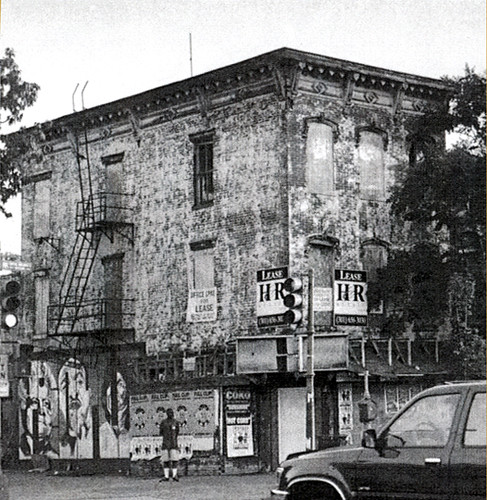 They weren't helpful with regard to the BP gas station proposal.
They weren't helpful with regard to the BP gas station proposal.There were big problems with the 600 block office buildings in terms of a failure of the project to generate additional revitalization energy.
Rather than rehabilitate, the CDC demolished the oldest buildings on the corridor at 8th and H and built a godawful one story building with a fake second floor--and they refused assistance and funding offered by the DC Executive Branch to construct a multi-floor building there at the outset.
(Above: the new building. Right: the older building on the corner, one of four. Obviously these buildings were disinvested, but could have been rehabilitated, the corner building was a fine example of the Italianate style.)
But, most all of the items in the H Street Urban Renewal Plan were accomplished, many by the H Street CDC
But they did do stuff, more than most of the other CDCs in the city.
But did the things they do contribute to H Street's improvement today?
Whether or not they did the right stuff and whether or not the community development community (a la the op-ed) learned anything from it is an open question.
I wrote about this in 2005, after the H Street CDC and a couple other CDCs won awards from the DC Building Industry Association, 3 years after a series of articles in the Washington Post excoriated their practices. See "Falling up -- Accountability and DC Community Development Corporations."
I'd say no, and if the residents and the city hadn't come to get reinvolved in the corridor, setting a new agenda, rather than the urban renewal agenda of the H Street CDC, it's pretty likely that H Street would have continued to languish, despite its proximity to downtown and Capitol Hill.
H Street's success today is the result of a new, post-urban renewal, revitalization agenda that was adopted despite the CDC
A new agenda was required (which is what happened in Columbia Heights, is happening in Petworth, and also in the Mount Vernon Triangle-New York Avenue area Downtown also).
And that's what we got, via residents and a then enlightened city government and a re-energized planning office along with a newly formed and engaged Department of Transportation that had been split off from the Department of Public Works.
And the CDCs enablers, including LISC and the then Fannie Mae Foundation (and the DC Dept. of Housing and Community Development) need to ask themselves hard questions also.
____________
* Recent changes in the H Street CDC agenda. With the retirement of former director Bill Barrow, the CDC has changed somewhat, but the voraciousness of the for profit real estate development market has long since overtaken the CDC and the former need to stoke development with public monies. They aren't a player anymore. They've been supplanted.
The CDC did benefit from the change, selling the two office buildings for a big profit, and selling the Autozone site too. Both will be redeveloped into mixed use projects.
And the CDC is participating in an innovative venture to redevelop the site of the RL Christian Library (see the blog entry "Hell is freezing over and pigs are flying: H Street edition".)
But they aren't drivers of the improvements. They've hopped on the bus like everyone else.
Labels: civic engagement, commercial district revitalization planning, community development, community organizing, neighborhood revitalization, urban design/placemaking, urban revitalization



3 Comments:
Great response to the CDC editorial. I'm amazed to see how much the corridor has changed since we were at the H Street Main Street meetings ten + years ago.
To me H Street can be seen both as a local story, which you've described here, and also an example of an ongoing cultural shift nationally. Whereas suburbanization started in the 1950s, today there seems to be a renewed interest in urban living. That may be influenced by several factors, including lower crime rates, congestion making suburban commutes unattractive, and the cool factor, among other things. But you've probably given that notion a lot of thought already.
-Brendan
In my head, which is fully of unicorns, I divide urban renewal into Richard Layman world, which is pretty organic, and GGW world, which is full of cranes and little white people.
I can see the value of creating a pre-Richard Layman world -- the CDC world? -- but have to agree there is almost no planting of little seeds there. At least in the DC context.
(rather a bit like U st where GGW style gentrication only came AFTER republic garden left)
So, yes, in the past 10 years transport > urban theory in terms of bringing people in. will that be true in the next 10 years?
Why does charlie think that everything about GGW is white people? He/she realizes that it's a diverse cast of characters, no?
Post a Comment
<< Home